Cedar Point – Sandusky, Ohio
“Millennium Force”. At the time of its debut, that was possibly the most pitch-perfect name imaginable for the coaster. We were in Y2K, the future was here now. Many parks try to give their coasters more timeless monikers, because they want their multi-million dollar investment to remain relevant for decades to come. Cedar Point took a daring step to give its 25-million dollar investment a name that was exceedingly of-the-moment, one that emphasized the here-and-now, don’t-blink-or-you’ll-miss-it excitement that had built up around the world’s first Gigacoaster. I remember standing in line for it during its first year of operation, and despite the four hour lines there was always this electric energy flowing through the masses suggesting we were all collectively joined by our desire to get our first taste of the future. This was back when they had to give out hand stamps with return times to enter the queue marked on it to manage the huge demand, and even still they had set up overflow queues underneath the final turn that has remained an empty concrete pad ever since. Maybe it was simply that everyone really wanted to ride a coaster with a 300 foot drop, but I still think there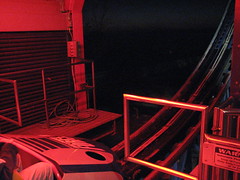 was something more intangible to its success during that debut year, almost a feeling that our lives had continuously been leading up to that very moment as we boarded the train in that neon-red station. The layout’s location along the Frontier Trail and over onto the once-deserted island made it hard to catch more than a fleeting glimpse of it from inside the park, that distant view across the bay when first arriving via the causeway was the best chance to see it in full, where it was still so far away and surreal looking one wondered if it was really an enigma. Despite all the worry about the Y2K viruses and promises of hover cars, the new millennium didn’t seem that different from the 1990’s in our day-to-day lives… except for when we visited Cedar Point. That was where the new Millennium was found.
was something more intangible to its success during that debut year, almost a feeling that our lives had continuously been leading up to that very moment as we boarded the train in that neon-red station. The layout’s location along the Frontier Trail and over onto the once-deserted island made it hard to catch more than a fleeting glimpse of it from inside the park, that distant view across the bay when first arriving via the causeway was the best chance to see it in full, where it was still so far away and surreal looking one wondered if it was really an enigma. Despite all the worry about the Y2K viruses and promises of hover cars, the new millennium didn’t seem that different from the 1990’s in our day-to-day lives… except for when we visited Cedar Point. That was where the new Millennium was found.
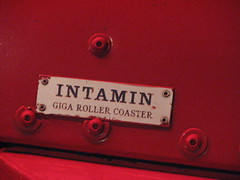 However, contrary to what the coaster’s tagline claims, the future was not riding on it; the future further passed it by with each new year, and now looking at it a full decade later the name can seem positively quaint. That said, the name is no longer spoken as a bold statement of “MILLENNIUM … FORCE” as it was when it opened. Now it’s one of those names you say in a single breath, “millenniumforce”, any literal meaning to the words having long been abandoned by the collective conscious and it’s just a phonetic string of syllables that directly conjures whatever mental image one might have of that big blue and silver structure looming along the western shores of the Cedar Point peninsula. Similar is true of the coaster experience itself. Although it has become slightly outmoded in the past decade,
However, contrary to what the coaster’s tagline claims, the future was not riding on it; the future further passed it by with each new year, and now looking at it a full decade later the name can seem positively quaint. That said, the name is no longer spoken as a bold statement of “MILLENNIUM … FORCE” as it was when it opened. Now it’s one of those names you say in a single breath, “millenniumforce”, any literal meaning to the words having long been abandoned by the collective conscious and it’s just a phonetic string of syllables that directly conjures whatever mental image one might have of that big blue and silver structure looming along the western shores of the Cedar Point peninsula. Similar is true of the coaster experience itself. Although it has become slightly outmoded in the past decade,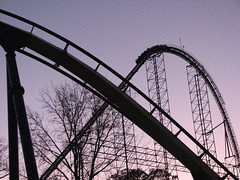 especially as we now have Kings Dominion’s Intimidator 305 to compare side-by-side to see the advancements Intamin has made in their design technique (Transitions no longer take several seconds to complete! Long overbanks are replaced with high-energy s-turns! The entire lift hill uses only two supports!) Millennium Force has managed remarkably well at remaining relevant, still as much of a crowd-pleaser as ever, even as it has become more of a familiar old friend rather than the unbounded enigma it used to be. Of course it helps to come right at the end of an economic boom and be followed by a decade of trying to find new ways to scale back the costly excesses of the late 90’s/2000, it’s taken a full decade for another park to attempt a coaster on the scale of Millennium Force, the ride retaining its crown by default.
especially as we now have Kings Dominion’s Intimidator 305 to compare side-by-side to see the advancements Intamin has made in their design technique (Transitions no longer take several seconds to complete! Long overbanks are replaced with high-energy s-turns! The entire lift hill uses only two supports!) Millennium Force has managed remarkably well at remaining relevant, still as much of a crowd-pleaser as ever, even as it has become more of a familiar old friend rather than the unbounded enigma it used to be. Of course it helps to come right at the end of an economic boom and be followed by a decade of trying to find new ways to scale back the costly excesses of the late 90’s/2000, it’s taken a full decade for another park to attempt a coaster on the scale of Millennium Force, the ride retaining its crown by default.
Despite its years spent at the number one position in steel coaster polls, rivaled only by Millie’s also 2000 debuting smaller brother Superman: Ride of Steel (now Bizarro), there is a small but growing group of enthusiasts that claim the ride (at least everything after the first drop) is not a particularly good one, overdrawn, simplistic, too much time between elements that are a bit boring to begin with… “Millennium Forceless” is a nickname you may be familiar with, assuming you haven’t used it yourself. Airtime is always fun, assuming its present which it sometimes isn’t these days, and overbanks are overrated, so the need for four of them is a complete redundancy. The bunny hop near the end of the ride usually delivers, but then it’s followed up by a long straight run of track, and finished with another overbank that does little in terms of forces. If you like height and sustained speed, Millennium Force is still your ride. But like the Beast before it, more refined coaster connoisseurs have learned that despite the record-breaking statistics there’s not much in terms of substance and have begun to turn their nose up at the once adored, the ride’s continued popularity attributed to nostalgia or a lack of awareness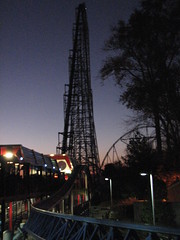 of more aggressive, dynamic coasters at other less-visited parks.
of more aggressive, dynamic coasters at other less-visited parks.
I agree. When it first opened I was swept into the euphoria of riding a coaster this towering and magnificent, but the more I went on it the more I had to scale back my appreciation of the giant, and today I have no less than three other coasters at Cedar Point I would take over Millie any day of the week (Magnum, Maverick and Raptor for those wondering). I heartily ripped on Diamondback for being a static, unimaginative riding experience designed only to provide as much airtime as possible… and that ride has the advantage of actually having sustained, strong airtime! Millennium Force starts with the disadvantage of having more restrictive restraints that make it harder to enjoy the openness of exposure to the forces, and exacerbates issues by striving for sustained floater, which it was able to achieve in its first few years, but joints inevitably start sticking and vibrations start to pick up; it’s not uncommon for the entire trainload to sit as firmly in their seats as they would at home in their living room couch on any early morning run on the Force.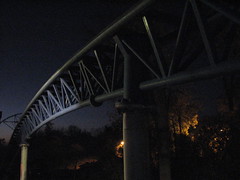
Now before I get any angry letters reading “well I was on it last summer and I got sustained ejector over the hills!” please don’t assume that I’m lying or misrepresenting the facts, this is true of all coasters, they perform differently from day-to-day, hour-to-hour, sometimes even from cycle-to-cycle. Occasionally Millennium Force does provide quite a bit of sustained floater, even borderline ejector over the main camelback humps. On my last visit on closing day in November, the early morning rides were exactly as I first described (100% A.I.S.), and by the last night rides there was never a moment where we felt like forces were promised but not delivered in full—and this was in the November cold! So the ride can be temperamental to say the least.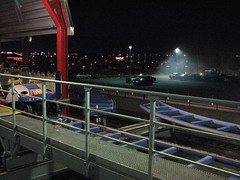
However, if you’ve read enough of my other reviews on this site you’ll know that simply sustaining forces for the sake of experiencing forces by themselves is something I will argue long and hard against as criteria for establishing a coaster’s worth. It’s all about the context of the forces, the pacing, the progression, the nuances that make forces just a single brushstroke for the full painting that is a roller coaster. I will agree that having a long hill that fails to produce anything of interest is almost always a detracting point, suggesting an attempt at a grand statement but stumbling miserably over it. But when someone tells me I’m wrong in my dismissal of a B&M speed coaster because it’s not just weak floater but actually tons of ejector over the tops of the hills, I’ll just shrug my shoulders and reply “whether that’s true or not, barely zero-g’s or strong negative, it has nearly no impact on my judgment of the ride, you’re still talking in terms of forces solely for the sake of forces”. And that’s all Millennium Force seems to be about… long, sustained, frequently forceless forces. A bit of speed, a bit of height, nothing you can actually feel if you close your eyes except for some particularly gusty wind, and nothing more.
Aw crap, now I’ve made this too easy for me. I’ve been told by people that have read some of my other recent reviews that I’m a contrarian; I’m not sure if I completely agree but I see where they might be coming from. I like to consider a perspective that might not be as popular if I think there’s some validity to it and I try to avoid re-stating things I figure most informed readers already know, so I can see how that’s a recipe for a bit of contrarianism. Since I don’t want to disappoint expectations, I’m now in a bit of a dilemma for where to take this analysis. On the one hand Millennium Force is one of the most popular, beloved rides on the planet which makes it an obvious target to knock down, but on the other I’ve said all I really need to say against the coaster in the last few paragraphs and detailing my complaints even further would only become overkill, plus while the critical viewpoint of this ride is the minority perspective it’s not minority enough to be truly contrarian. Besides, as fun as it can be to play the role of a sophist and twist an argument into whatever perspective I like on a whim (as I’ve been accused of), there’s still an underlying commitment I feel to genuine philosophy to describe what actually is. And to be honest, while it’s not my favorite in the park, I still kind of like Millennium Force more than I might want to admit. I guess I’ll just have to bite the bullet and take a nuanced approach to assessing the ride… Heaven forefend, how will the enthusiast community manage? (Probably like they usually do by ignoring me because I’m not on TPR and the text-to-picture ratio is too thick to skim through.)
We have been loaded into the train, carefully adjusting our lapbar to the perfect position moments before the attendant comes around to properly staple us into place (actually the attendants haven’t leaned their weight on my restraint for a couple years now, I can usually go out with the bar at the position I want provided it’s still within a safe distance from my lap). The train nudges forward an inch or two, then propels out of the station, quickly tipping back and angling straight up the lift. It only takes about twenty-two seconds to get to the top so most enthusiasts quickly survey the surrounding vistas knowing that time is tight to enjoy this unique perspective; newcomers to the ride fixate (or desperately try not to) on their impending doom as they approach the top. The former personality should always take pleasure if they’re sitting behind a particularly animated case of the latter personality. About 2/3 of the way up the hill the speed increases, I think because the third train clears the last block when it pulls into the station (the interesting thing about MF is there are only four blocks along a course that runs three trains), but it’s an effective ploy to get everyone’s attention to snap ahead.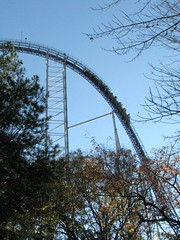 The curve over the crest is at once wide enough and yet has a far enough rotation to feel the pitch of the train roll forward and then over into the first drop. The front row achieves air just by virtue of hanging over it far enough and steep enough that riders are forced forward out of their seat; as the speed of the rest of the train finally catches them they get floater all the way down (pushed up against the seat back) simply because they are in free-fall. Forces in the back row quickly but smoothly escalate from light floater to strong negative g-forces. It’s technically ejector all the way down, although the force is not felt as much straight up out of the seat but pushing backwards as if trying to force the air out of one’s lungs, again because of the steep angle.
The curve over the crest is at once wide enough and yet has a far enough rotation to feel the pitch of the train roll forward and then over into the first drop. The front row achieves air just by virtue of hanging over it far enough and steep enough that riders are forced forward out of their seat; as the speed of the rest of the train finally catches them they get floater all the way down (pushed up against the seat back) simply because they are in free-fall. Forces in the back row quickly but smoothly escalate from light floater to strong negative g-forces. It’s technically ejector all the way down, although the force is not felt as much straight up out of the seat but pushing backwards as if trying to force the air out of one’s lungs, again because of the steep angle.
It takes a couple seconds to reach the bottom although a lot of the vertical freefall takes place along the pullout. This pullout itself takes several seconds to get through but the positive g’s are strong as it reaches maximum speed. When it first opened this speed was listed as 92mph, then they upped it to 93 a short while later. I had heard reports that in its opening year it was able to achieve 100mph given a high enough daily temperature. I have a slightly hard time believing that because the physics of a drop that steep should ensure it’s the same no matter what the circumstances, and things like weight, temperature or ‘newness’ should only affect how well it sustains speed over the course of the ride due to variances in the frictional coefficient.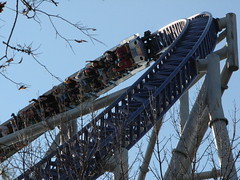
The g-forces along the first overbank sustain the positives felt along the pullout, if not increasing them despite working against gravity around the top. I remember my first ride ever on Millennium Force in the second row I nearly blacked out around the last part of the turn, and I continued to risk graying out for a couple years after that. Today I never have any such problems, possibly because the ride has slowed down enough already or my physiology has changed since then, but this is still probably one of the best places on any North American megacoaster outside of anything Giovanola-built to experience strong sustained positives. What’s also interesting about this turn is despite the 122° banking it can be very hard to judge one’s orientation with 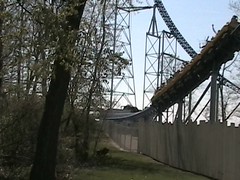 Earth because the forces are powerful enough to confuse your inner ear from being able to distinguish gravitational directionality at all.
Earth because the forces are powerful enough to confuse your inner ear from being able to distinguish gravitational directionality at all.
The train slowly twists out of the overbank and runs along a ground level curve to the left, the massive lift hill towers not far away. The timing between elements and transitions is very slow yet the speed still gives this stretch of track enough of an edge; notable g-forces are generally not present, at least in contrast to the overbank before it. A vibration usually accompanies this high-speed curve and has for much of the past decade. Hidden around the turn is a tunnel that rapidly approaches, the train plunging through it with no change to the ride dynamics which remain steady on the entire turn.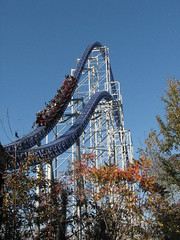
A gentle transition out of the tunnel and up into the 182 foot camelback hill. Unlike the first drop there’s no super-steep angle into or out of this hill, it has a very gentle pull-up, over and back down. Even on the best days the airtime along here isn’t designed to be any more than light floater… given the speed the train has at this point it makes sense to use it in this fashion, because it would allow for one of the longest periods of sustained floater in the world (the further a hill starts to go into the negative range for g-forces the more time is taken away from how long those forces could be held). Generally it lasts for at least four to five seconds, not too far from the record set by Superman The Escape which I think is six seconds, at least when it was launching at full speed which I don’t believe has happened in many years.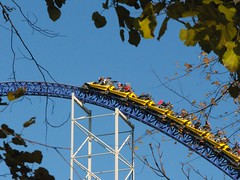 The danger of this approach of sustained floater air is that while zero-g’s can be fun, it borders really close to .1 g’s, which isn’t, and when the train starts going a bit slower than originally intended, that’s what you get instead and this hill becomes a dead spot. For the most part avoid riding in the morning; it normally always picks up speed throughout the day. Cold weather and rain can negatively impact the speed as well, but I’ve found not to as great of a degree as the time of day. Assuming you are able to get forces, they will be very gentle, straight up out of your seat, without as great of a distortion going forward or backward from a tight rotation or steep freefall out of the hill.
The danger of this approach of sustained floater air is that while zero-g’s can be fun, it borders really close to .1 g’s, which isn’t, and when the train starts going a bit slower than originally intended, that’s what you get instead and this hill becomes a dead spot. For the most part avoid riding in the morning; it normally always picks up speed throughout the day. Cold weather and rain can negatively impact the speed as well, but I’ve found not to as great of a degree as the time of day. Assuming you are able to get forces, they will be very gentle, straight up out of your seat, without as great of a distortion going forward or backward from a tight rotation or steep freefall out of the hill.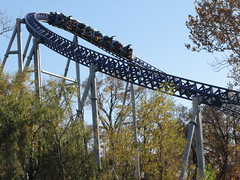
Once again there is a very long transition, the timing taking a couple seconds to get between the previous camelback hill pullout and into the second turn. This one is technically more of an inclined helix and isn’t included in the official count of the overbanked turns, but I count it with them anyway because it matches closely and it actually does go a few degrees past ninety for a moment on the way down. From the base of the turn to the transition out of it at the other end it takes close to eight seconds to make it all the way around. Forces are what you would probably expect: feather light positives. The last stretch of this curve sticks close to the ground and dodges a few supports from the way it came in, once again a slow transition into the next overbank turn, this one much taller and angled, a steeper pitch at the top and shorter element time. You can feel a few rotational effects at the 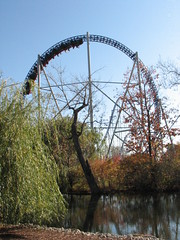 top as some minor positive g-forces once again make a quick appearance before vanishing once more. At the bottom there’s a quick skirt to the right narrowly cutting past a few more supports as the track sets up the return camelback hill. In terms of uplift, I’ve found this one to perform more consistently over my past few visits, the timing still taking several seconds to complete, especially when one factors in the long flat section leading out of it in order to make it about the same length as the first camelback so the tunnels could match up.
top as some minor positive g-forces once again make a quick appearance before vanishing once more. At the bottom there’s a quick skirt to the right narrowly cutting past a few more supports as the track sets up the return camelback hill. In terms of uplift, I’ve found this one to perform more consistently over my past few visits, the timing still taking several seconds to complete, especially when one factors in the long flat section leading out of it in order to make it about the same length as the first camelback so the tunnels could match up. I’m always surprised that so much speed has been lost in the course of two overbanked curves that the return camelback needed to be so much smaller, but I suppose the speed is great enough that the same amount of distance covered between the two is about the same as an average medium sized coaster, just covered in about twenty seconds instead of a minute and a half.
I’m always surprised that so much speed has been lost in the course of two overbanked curves that the return camelback needed to be so much smaller, but I suppose the speed is great enough that the same amount of distance covered between the two is about the same as an average medium sized coaster, just covered in about twenty seconds instead of a minute and a half.
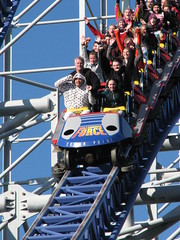 This second tunnel is physically much shorter than the first, although they take about the same time to complete. A strobe light flashes before the exit for the photo opportunity. Perhaps it’s just as well that there have been no discernable forces experienced since cresting the camelback several hundred feet ago, it allows everyone on the train ample time to find the right pose for the camera, which is a favorite tradition among casual fans and families visiting Cedar Point. Out of the tunnel, the curve continues for another hundred feet or so and, for the first time on the entire ride we reach an element that doesn’t take several seconds to complete. The bunny hop that parallels the station always provides a decent boost no matter what the rest of the ride had been like, quickly banking into a left turn before twisting out again, the summation
This second tunnel is physically much shorter than the first, although they take about the same time to complete. A strobe light flashes before the exit for the photo opportunity. Perhaps it’s just as well that there have been no discernable forces experienced since cresting the camelback several hundred feet ago, it allows everyone on the train ample time to find the right pose for the camera, which is a favorite tradition among casual fans and families visiting Cedar Point. Out of the tunnel, the curve continues for another hundred feet or so and, for the first time on the entire ride we reach an element that doesn’t take several seconds to complete. The bunny hop that parallels the station always provides a decent boost no matter what the rest of the ride had been like, quickly banking into a left turn before twisting out again, the summation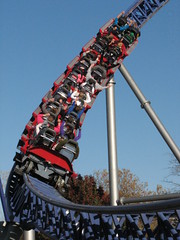 of these last couple maneuvers all completed in less time than any single element that came earlier. There’s a stretch of straight track that runs parallel to the queue as it anticipates the final overbank. A second bunny hill probably would have been nice, after a full ride of lethargic timing it would have been a good idea to end it with a string of elements that had some pep in them. That said, this straight section can still be used to enjoy the sustained speed for a few seconds, to laugh at all the suckers still waiting in the queue, or if this is on an early morning ride session (available to Cedar Point Resort guests and Platinum Pass holders) to figure out if the wait is still short enough for a re-ride before heading back to Maverick, assuming the ride hasn’t sucked so badly that a re-ride would not be necessary even if it was still a walk-on. But still, a second bunny hill would have been nice.
of these last couple maneuvers all completed in less time than any single element that came earlier. There’s a stretch of straight track that runs parallel to the queue as it anticipates the final overbank. A second bunny hill probably would have been nice, after a full ride of lethargic timing it would have been a good idea to end it with a string of elements that had some pep in them. That said, this straight section can still be used to enjoy the sustained speed for a few seconds, to laugh at all the suckers still waiting in the queue, or if this is on an early morning ride session (available to Cedar Point Resort guests and Platinum Pass holders) to figure out if the wait is still short enough for a re-ride before heading back to Maverick, assuming the ride hasn’t sucked so badly that a re-ride would not be necessary even if it was still a walk-on. But still, a second bunny hill would have been nice.
But I digress: the final overbank. If you don’t like overbanked maneuvers then this one may seem to be the least interesting. However, I think this is probably the second best overbank on the ride, after the forceful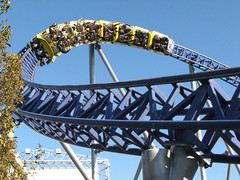 first overbank. There’s this jazzy little back-and-forth to the rotation in banking that gives this turn some character. First a little prebank up and into the turn. The banking rotation then stops as the track curves straight up (which is actually now diagonal because of the first part of the transition into it). As it begins to slow, there’s another quick rotation all the way around the top of the curve, tipping us just past ninety before angling down and around our heartline axis once more. The way out mirrors the way in, with a halt in the rotation of the banking pitch, leveling out a little bit more before a final rightward-tipping shimmy sets us up for the magnetic brakes. Nothing intense, but infinitely more interesting than if it had been one continuous motion like the other overbanked turns.
first overbank. There’s this jazzy little back-and-forth to the rotation in banking that gives this turn some character. First a little prebank up and into the turn. The banking rotation then stops as the track curves straight up (which is actually now diagonal because of the first part of the transition into it). As it begins to slow, there’s another quick rotation all the way around the top of the curve, tipping us just past ninety before angling down and around our heartline axis once more. The way out mirrors the way in, with a halt in the rotation of the banking pitch, leveling out a little bit more before a final rightward-tipping shimmy sets us up for the magnetic brakes. Nothing intense, but infinitely more interesting than if it had been one continuous motion like the other overbanked turns.
Sliding forward into the magnetic brakes, the front of the train might even be going fast enough to catch a whiff of laterals on the small right turn between the main deceleration area and the main block area before the unload station. The op at the unload platform calls out “Welcome back Millennium Force riders, how was your ride?!”, those last four words always emphasized with a precisely toned pattern, and everyone on the train erupts into cheers, most likely including yourself, either out of sincerity or politeness. But if you’re a well-traveled, well-informed, disciplined coaster connoisseur, there’s probably a fifty-fifty chance a voice in the back of your head is telling you, “That was overrated. Completely forceless after the first turn, Cedar Point just wanted to build a record-breaking ride to lure enthusiasts to the park but told Intamin to keep it gentle enough so all these casual park-goers and families around me won’t be scared off by it.” Besides, it’s a necessity that the sense of pace is going to be slow on a coaster this big no matter how forceful they make it;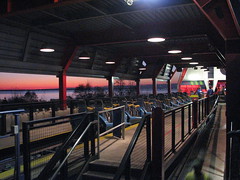 that might sound counterintuitive at first, but as you increase the rate of speed linearly, the forces generated by a particular element increase by a greater factor than the time it takes to complete them is reduced by, so to maintain survivable forces means the elements have to be made large enough that the time it takes to get around them is much longer than if the ride were half its size. (fyi, that’s why kiddie coasters can sometimes feel so vicious; the slow speed means it can complete a bunny hop in a fraction of a second without extreme forces generated. Try the same thing going 90 miles per hour and the airtime could be capable of bending steel. So by this seemingly backwards logic, when it comes to the timing between elements that generates an exciting pace, slower=faster and vice versa.)
that might sound counterintuitive at first, but as you increase the rate of speed linearly, the forces generated by a particular element increase by a greater factor than the time it takes to complete them is reduced by, so to maintain survivable forces means the elements have to be made large enough that the time it takes to get around them is much longer than if the ride were half its size. (fyi, that’s why kiddie coasters can sometimes feel so vicious; the slow speed means it can complete a bunny hop in a fraction of a second without extreme forces generated. Try the same thing going 90 miles per hour and the airtime could be capable of bending steel. So by this seemingly backwards logic, when it comes to the timing between elements that generates an exciting pace, slower=faster and vice versa.)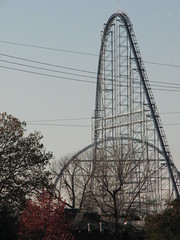
Where I think a lot of Millennium Force critics go wrong during their assessment of the ride is they react to the experience too passively, waiting for the ride’s incredible size and power to actively shake them from their catatonic indifference at every moment. This coaster’s not going to do that to you the way a Voyage or a Maverick would. My play-by-play analysis above made the same mistake, looking just at the quantity of forces or timing between elements. If you’re a seasoned coaster rider that long ago overcame any acrophobia or tachophobia, and you just sit in your seat waiting to be hit with extreme, forceful sensations you will more likely than not be underwhelmed if not flat-out bored when you get back to the final brakes. You may also notice that the people around you that were excited before the ride began were excited afterward, while the few that were indifferent before the ride were only slightly less indifferent when they came off it as well. This might be easy to label a self-fulfilling prophecy but I think there’s a bit more going on to differentiate the two groups than just that.
When a trainload of riders gets back to the station cheering and clapping, it’s not necessarily because they all thought the ride was forceful, intense or full of unpredictable direction changes, at least once they understand what those terms mean and have points of reference with other coasters that actually are those things. There are a lot of ‘peripheral sensations’ that accompany a Millennium Force experience, mostly those related to the raw speed, sense of movement through space, and extreme changes of perspective. In the first case, raw speed, consider the sensations of traveling in an open-air car at 93mph: even if it’s not being used to achieve anything particularly forceful, the slight vibrations in the cars or the wind that draws tears from your eyes can be quite intimidating on their own. Next, there’s the sense of movement through space, a factor related to the raw speed. On the first ground-level left hand turn, again forces aren’t strong and the movement is sustained for several seconds, but the sense of ground rushing by, the rapid parallax with the trees off to the left or the lift hill support towers to the right, and seeing the tunnel approach and pass by within a split second,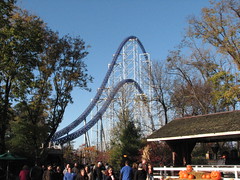 knowing that these objects are all real and not just some virtual simulation, not only would I call that a great experience, but for many people it can register as information overload, a real adrenaline rush created just from watching. And then thirdly there’s the extreme changes in perspective. You cover a lot of ground on Millennium Force, and some pretty dramatic altitude changes. Just having the ability to change perspectives from ground level to 182 feet in the air, even if it doesn’t happen rapidly enough to sustain strong forces, is something few people get to experience on a regular basis; normally our perspective with the outside world is stuck or changes very slowly, to be able to actually see that extreme perspective change take place is reason by itself to become giddy.
knowing that these objects are all real and not just some virtual simulation, not only would I call that a great experience, but for many people it can register as information overload, a real adrenaline rush created just from watching. And then thirdly there’s the extreme changes in perspective. You cover a lot of ground on Millennium Force, and some pretty dramatic altitude changes. Just having the ability to change perspectives from ground level to 182 feet in the air, even if it doesn’t happen rapidly enough to sustain strong forces, is something few people get to experience on a regular basis; normally our perspective with the outside world is stuck or changes very slowly, to be able to actually see that extreme perspective change take place is reason by itself to become giddy.
Now, many veteran coaster enthusiasts are still able to enjoy these ‘peripheral sensations’ while others can be left cold. Again, this might seem to be a self-fulfilling prophecy, that those that start the ride excited return excited, while those indifferent return indifferent. Not necessarily. Being able to start the ride with a bit of an adrenaline boost can help to open one’s nervous receptors so they become more acutely aware of these sensations happening around them, while those that aren’t will be more closed in during the ride and just thinking about the actual forces or direction changes, which of course are going to be weak and slow. Therefore it could be said that those that start the ride with a bit of an adrenaline buzz quite literally experience more than those that do not, and that can account for the discrepancy between the two attitudes rather than simply attributing it to taste. (But this is all totally unscientific speculation)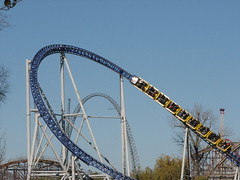
So if you’re one of the types that love Millennium Force, that’s fantastic. But what if you just can’t, for the life of you, get into the whole experience? I’m that way myself, but after enough visits to Cedar Point I’ve found ways to more actively engage in the ride instead of just passively sitting there thinking “this is overrated”. First of all, I keep my hands down, and I wish other people would as well, it would cut down on the wind resistance and make it easier for people behind them to see. Second, I recommend sitting on the right side of the train. This way on three of the four overbanked turns you can look (and maybe even lean over a little bit) straight down with absolutely nothing between you and the ground far below 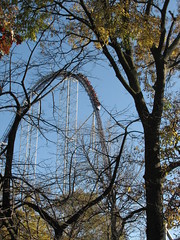 (also some of the supports on the first overbank come really close, one even having a notch cut out where rider’s hands could conceivable reach). The first drop offers plenty of opportunities to ride in different ‘styles’. First of all, no matter what seat you’re in, try actually following the posted guidelines and keep your back pressed flat against the seat back with your head looking forward against the headrest. The sense of angular change and the steepness of the drop is strongly heightened, partly because it removes the ‘pillow’ of starting the drop by leaning forward slightly and later shifting against the seat back on the pullover dampening the angular rotation, partly because it prevents you from looking at a fixed perspective point, and also because removed any sense of control over your experience; the cumulative result can add to the drop’s intensity, especially once you start to approach 80°. For last-row riders only, one other thing you could try is looking backwards as you go over the first drop, it can be quite terrifying for obvious reasons (officially this is against park rules and possibly for good reason, so use your better judgment before trying this; it doesn’t put anyone else at risk so I don’t agree with outright prohibiting it for libertarian reasons, besides there’s no way they can enforce it).
(also some of the supports on the first overbank come really close, one even having a notch cut out where rider’s hands could conceivable reach). The first drop offers plenty of opportunities to ride in different ‘styles’. First of all, no matter what seat you’re in, try actually following the posted guidelines and keep your back pressed flat against the seat back with your head looking forward against the headrest. The sense of angular change and the steepness of the drop is strongly heightened, partly because it removes the ‘pillow’ of starting the drop by leaning forward slightly and later shifting against the seat back on the pullover dampening the angular rotation, partly because it prevents you from looking at a fixed perspective point, and also because removed any sense of control over your experience; the cumulative result can add to the drop’s intensity, especially once you start to approach 80°. For last-row riders only, one other thing you could try is looking backwards as you go over the first drop, it can be quite terrifying for obvious reasons (officially this is against park rules and possibly for good reason, so use your better judgment before trying this; it doesn’t put anyone else at risk so I don’t agree with outright prohibiting it for libertarian reasons, besides there’s no way they can enforce it).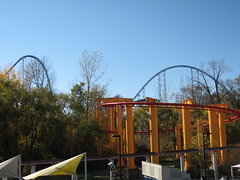 And for front row riders, if you waited over 45 minutes extra in line you probably want to get all the use out of your front row position as possible; lean way forward on the first drop, you’ll essentially be inverted at the steepest point and it’s an amazing visceral experience. On night rides during Halloweekends when they’re running the Fright Zone along the Frontier Trail, there usually will be a lot of fog that drifts into and around the first drop area, and the result can be surreal. On one ride in the front row I leaned all the way forward and the drop was completely encased in thick fog, just as the lights on the lift columns had changed to red; the effect was not unlike plunging head-first into the bottomless stygian abyss of hell. In 2008 Cedar Point added a new pirate-themed haunt on Millennium Island, which by itself I thought was a pretty lame walk-through, but the real benefit comes to Millennium Force riders where the fog can be so thick that the entire middle section is spent not able to see fifty feet ahead of you. I don’t care what your definition of a great coaster is, get a good night ride on Millennium Force during Halloweekends when the fog and running conditions are right and I’m fairly confident your mind will be blown just from the visual experience.
And for front row riders, if you waited over 45 minutes extra in line you probably want to get all the use out of your front row position as possible; lean way forward on the first drop, you’ll essentially be inverted at the steepest point and it’s an amazing visceral experience. On night rides during Halloweekends when they’re running the Fright Zone along the Frontier Trail, there usually will be a lot of fog that drifts into and around the first drop area, and the result can be surreal. On one ride in the front row I leaned all the way forward and the drop was completely encased in thick fog, just as the lights on the lift columns had changed to red; the effect was not unlike plunging head-first into the bottomless stygian abyss of hell. In 2008 Cedar Point added a new pirate-themed haunt on Millennium Island, which by itself I thought was a pretty lame walk-through, but the real benefit comes to Millennium Force riders where the fog can be so thick that the entire middle section is spent not able to see fifty feet ahead of you. I don’t care what your definition of a great coaster is, get a good night ride on Millennium Force during Halloweekends when the fog and running conditions are right and I’m fairly confident your mind will be blown just from the visual experience.
Millennium Force is like an uncircumcised penis. Wow, I am positive that if you were just scrolling through the article to look at the pictures, after seeing that phrase out of the corner of your eye you started reading. So, while I briefly have your attention I’m going to get through some nerdy layout sequencing analysis before explaining what prompted me to make the above comment. I always have respect for a coaster whose layout isn’t just a semi-random sequencing of elements and has some logical order to it, with a sense that each moment is somehow predicated by the one before and after it, at least once the ride is over and you can step back and look at the entire experience as a whole. While the long transitions and flat, sustained forces in a layout that’s an odd collection of hills and overbanked turns might seem like a ripe formula for random dreck, I’ve actually found a very formal sequencing to each of the elements that, even if I’m bored stiff by the weak forces and long transitions, I can at least appreciate as an overall layout. There’s a pattern of brief, strong airtime (red, 1); sustained, floater airtime (blue, 1); overbanked turns (2), both forceful/interesting (red) or basic and sustained (blue); with segments of ground-level, sustained speed turns with tunnels (…3…) that can be written as such:
(1, 2) …3… 1, 2, 2, 1 …3… (1, 2)
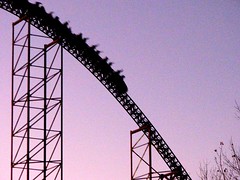 Hopefully both fans and skeptics of the ride can appreciate the symmetry of the ride’s layout. I should make some more clarifications and specifications in the above structure: although the first (1,2) and second are very different experiences from each other, both stand out, the first for the forcefulness and extreme height and speed, and the second for the faster timing and greater variety of force sensations (also why I think a second bunny where the flat section currently is would greater benefit the ride, to help the finale better match the opening act in terms of intensity/distinctness, it’s still too weak to make a proper counter-balance). The overbanks should also be noted are each different from each other, so while the overall structure of the ride mirrors itself, there’s a linear progression to each of the overbanks that helps the ride from becoming too repetitive: the first forceful and mostly circular, the second wide and sweeping, the third taller and steeply banked at the top, the final with the funky back-and-forth to the banking rotation that I mentioned earlier. Obviously if it’s analyzed too closely the structure starts to fall apart because there are moments that don’t fit, but stuff like sequencing has less to do with adrenaline than it does with simply having a greater appreciation
Hopefully both fans and skeptics of the ride can appreciate the symmetry of the ride’s layout. I should make some more clarifications and specifications in the above structure: although the first (1,2) and second are very different experiences from each other, both stand out, the first for the forcefulness and extreme height and speed, and the second for the faster timing and greater variety of force sensations (also why I think a second bunny where the flat section currently is would greater benefit the ride, to help the finale better match the opening act in terms of intensity/distinctness, it’s still too weak to make a proper counter-balance). The overbanks should also be noted are each different from each other, so while the overall structure of the ride mirrors itself, there’s a linear progression to each of the overbanks that helps the ride from becoming too repetitive: the first forceful and mostly circular, the second wide and sweeping, the third taller and steeply banked at the top, the final with the funky back-and-forth to the banking rotation that I mentioned earlier. Obviously if it’s analyzed too closely the structure starts to fall apart because there are moments that don’t fit, but stuff like sequencing has less to do with adrenaline than it does with simply having a greater appreciation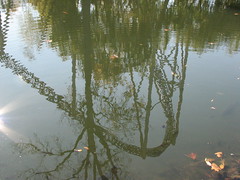 for the coaster after the ride is over. Now, about that odd analogy…
for the coaster after the ride is over. Now, about that odd analogy…
When I first was working out that sequencing pattern, I realized that the symmetry to the elements could even be seen from the overhead view of the layout itself. So I drew out a rough sketch of that layout to be able to illustrate what I meant, only to discover afterward that it looked a lot like… with the first and last overbanks being the… the side-by-side camelback hills forming the… and the two island overbanks being… yep.
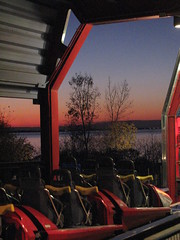 When I was younger I used to think a lot of Freud’s theories (at least the ones that made it into pop culture) were something of a joke, but as I grew older I came to realize how true they could be, especially having spent a lot of time in online enthusiast forums. Sometimes a cigar is just a cigar, the same as it is possible to visit Cedar Point and climb aboard that massive woodie that is Mean Streak, then going over to Power Tower to ride up and down an erect shaft several times before finishing the day by launching an enormous white plume of liquid on Snake River Falls and have absolutely nothing subconsciously implied whatsoever. (I am so sorry the analysis has devolved this far. I promise my next one will have a paragraph or two contemplating the epistemological uncertainty that is a necessary condition of all human intellectual endeavors, but for now you’re stuck with juvenile sexual innuendo.)
When I was younger I used to think a lot of Freud’s theories (at least the ones that made it into pop culture) were something of a joke, but as I grew older I came to realize how true they could be, especially having spent a lot of time in online enthusiast forums. Sometimes a cigar is just a cigar, the same as it is possible to visit Cedar Point and climb aboard that massive woodie that is Mean Streak, then going over to Power Tower to ride up and down an erect shaft several times before finishing the day by launching an enormous white plume of liquid on Snake River Falls and have absolutely nothing subconsciously implied whatsoever. (I am so sorry the analysis has devolved this far. I promise my next one will have a paragraph or two contemplating the epistemological uncertainty that is a necessary condition of all human intellectual endeavors, but for now you’re stuck with juvenile sexual innuendo.)
(Header banner photo credit to Anthony Harrison, used with permission)


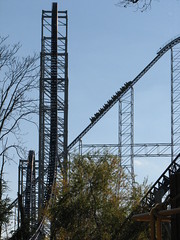

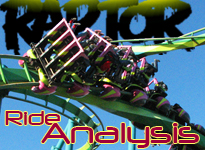
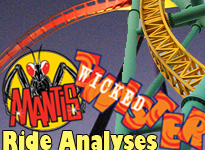

Comments